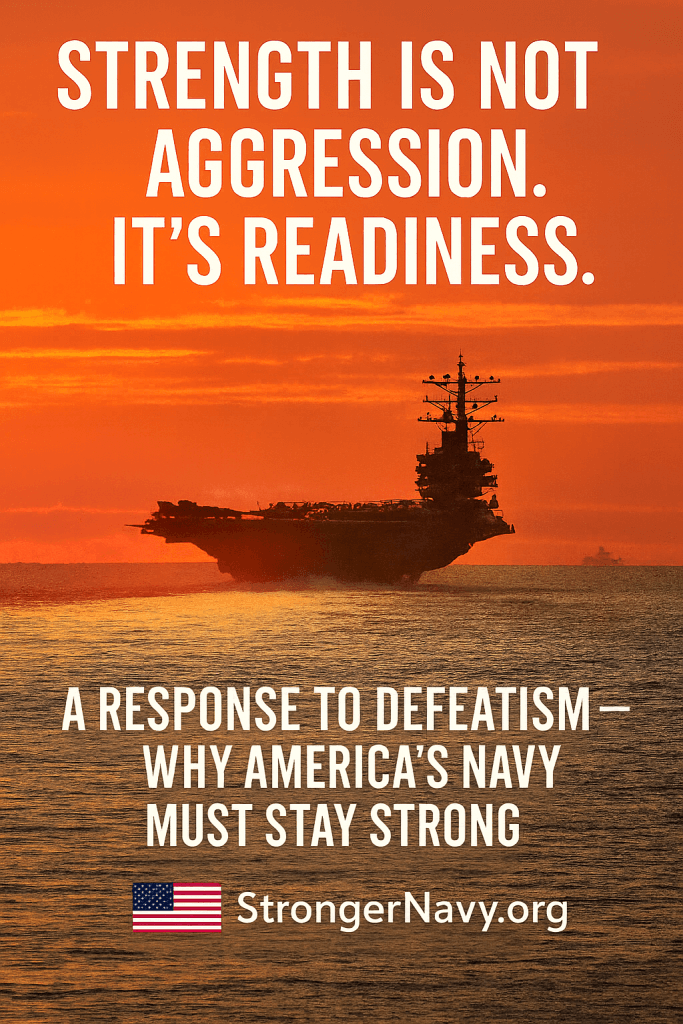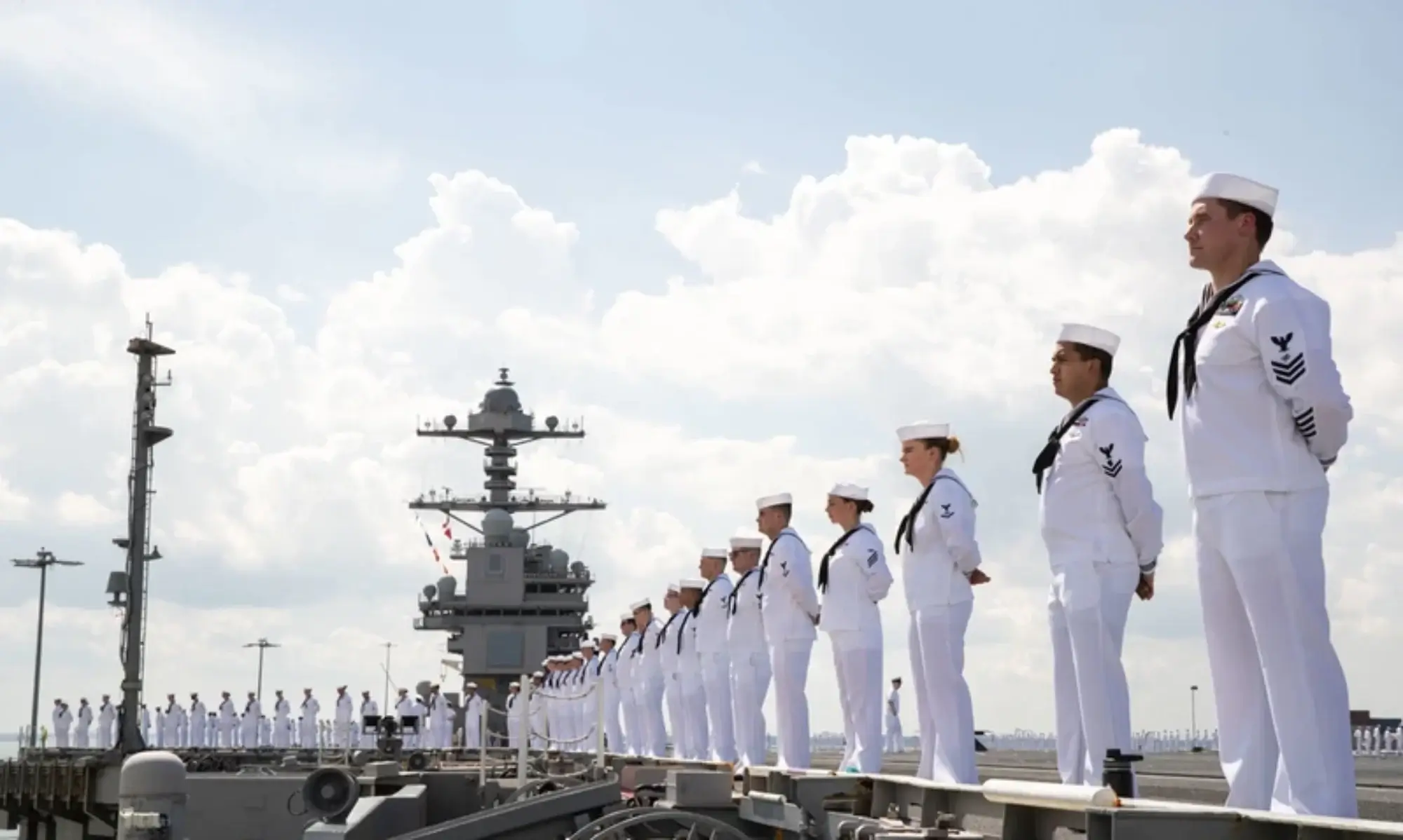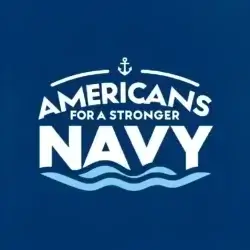
By Bill Cullifer, Founder Americans for a Stronger Navy
Today, October 13, 2025, marks the 250th anniversary of the United States Navy. It’s a moment to celebrate two and a half centuries of service, sacrifice, and dedication to protecting freedom of the seas. It’s also a time to reflect on the challenges ahead—and to clarify what I mean when I advocate for a Stronger Navy.
For some, the phrase “a stronger Navy” may sound like a call to arms or empire-building. It’s not. My advocacy has always been rooted in one simple truth: a strong Navy preserves peace, protects prosperity, and prevents wars.
And by “stronger,” I don’t mean the Navy is weak. Far from it. The men and women serving today are the best-trained, best-equipped, and most capable sailors in the world. But they’re being asked to do more—to cover more oceans, deter more threats, and respond to more crises with fewer ships and tighter resources than ever before. “Stronger” means giving them what they need to succeed: modern tools, sufficient numbers, and unwavering public support.
Strength is not aggression. It’s deterrence. It’s readiness. It’s the quiet assurance that when freedom is threatened, the United States and its allies can respond decisively and responsibly.
Recently, a prominent economist claimed the “Western era is over,” that American leaders are “delusional” for maintaining global commitments, and that we should accept a “multipolar world” dominated by nations like China and Russia. His argument deserves a response—not because debate is unwelcome, but because democratic principles and freedom of the seas are at stake.
The Dangerous Myth of Inevitable Decline
The Argument: The West represents only 12 percent of the world’s population and can no longer lead.
The Reality: Power has never been about population alone. If it were, India would dominate China, and Indonesia would be a superpower. What matters is:
- Technological Innovation: The United States leads in AI, semiconductors, biotechnology, aerospace, and space.
- Alliance Networks: Over 30 treaty allies choose to align with us—authoritarians coerce; we attract.
- Economic Dynamism: The dollar still anchors ~56–58 percent of global reserves (IMF COFER Q2 2025).
- Naval Projection: We operate globally; our competitors remain largely regional powers.
The U.S. Navy doesn’t maintain 11 carrier strike groups because we’re “delusional.” We maintain them because freedom of navigation matters, our allies depend on us, and deterrence works.
The False Choice Between Strength and Diplomacy
The Argument: Maintaining a strong Navy is provocative; we should just “talk” to our adversaries.
The Reality: Weakness invites aggression. History proves it.
- Finland joined NATO on April 4, 2023, and Sweden on March 7, 2024—proof that accommodation fails.
- China continues to build aircraft carriers and overseas bases.
- Pacific allies—Japan, South Korea, Australia, and the Philippines—want more U.S. presence, not less.
Peace through strength isn’t a slogan. It’s the most successful deterrent model in modern history. The post–Cold War era of American naval dominance was also the most peaceful.
What’s Really at Stake: Democratic Principles
This isn’t about dominance—it’s about the kind of world we want to live in.
Authoritarian Model:
- Borders redrawn by force
- “Might makes right”
- International law ignored
- Smaller nations coerced
Democratic Model:
- Sovereignty respected
- Sea lanes open to all
- Collective security honored
- Law upheld
When we maintain a strong Navy, we’re protecting a system that has lifted billions from poverty through free trade and open seas.
The China Challenge: Clear-Eyed Assessment
China has grown, but its vulnerabilities are glaring.
Geographic Disadvantages:
- Roughly 80 percent of its oil imports pass through the Strait of Malacca—a chokepoint and wartime liability.
- Trapped behind the First Island Chain with few friendly overseas bases.
Economic Fragilities:
- Over $13 trillion in local-government debt
- Property sector collapse
- Shrinking population since 2015
- No immigration, worsening demographic decline
Military Limitations:
- No combat experience since 1979
- Carrier operations still rudimentary
- Submarine fleet far noisier than ours
- No ability to sustain power projection beyond Asia
Alliance Deficit:
- North Korea is its only treaty ally
- India remains a rival
- ASEAN partners are wary
- Russia is a partner of convenience, not trust
Meanwhile, the U.S. Navy operates from 80 years of combat experience, forward bases on every ocean, interoperable fleets with allies, unmatched logistics, and the world’s most advanced submarine force.
Why We Cannot Rest
Some say multipolarity is inevitable. History says otherwise. Multipolar systems are less stable:
- Early 1900s Europe: two world wars, 100 million dead
- Cold War bipolarity: no great-power wars
- Post-Cold War unipolarity: most peaceful period in modern history
The question isn’t whether we can maintain naval strength—it’s whether we will.
The 250th Anniversary Call
As we celebrate 250 years of service, we face a choice.
Option One: Accept decline, draw down the fleet, and hope aggressors respect our weakness.
Option Two: Recognize that deterrence requires both capability and will. Modernize with unmanned systems, AI, and hypersonics. Maintain forward presence. Stand with allies.
What “Not Resting” Means in Practice
- Build the 381+ Ship Fleet
- Current fleet: ~296 ships (Dec 2024 baseline)
- Requirement: 381 manned + 134 unmanned for full readiness
- China’s PLAN: ~370 ships now, projected 395 by 2025 and 435 by 2030
- Embrace Technological Transformation
- Unmanned surface and underwater vehicles
- AI-enhanced command and control
- Hypersonic weapons
- Space-based sensing and communications
- Cyber resilience
- Strengthen Pacific Presence
- AUKUS and Quad partnerships
- Expanded exercises with Japan, Australia, the Philippines, and South Korea
- Maintain Atlantic Vigilance
- Monitor Russia’s submarine activity
- Secure Arctic and Baltic approaches
- Protect Global Commerce
- South China Sea: ~$3.4 trillion in annual trade
- Suez, Red Sea, and Persian Gulf choke points
- Panama Canal and Caribbean routes
Preserving and Projecting Democratic Values
We must do more than preserve freedom of the seas—we must project the values that make that freedom possible.
- Transparency Over Opacity: We publish our strategy; authoritarians conceal theirs.
- Rule of Law: We uphold international law; competitors ignore it.
- Alliance Over Coercion: Nations choose to partner with us.
- Innovation Over Theft: We invent; China steals ~$600 billion in IP annually.
- Professionalism Over Intimidation: Our sailors serve as ambassadors of democracy.
Every humanitarian mission, disaster response, and joint exercise demonstrates what democratic power means.
A Message to Our Shipmates
To those who serve and have served—you inherit a 250-year tradition of defending freedom of the seas. From wooden frigates to stealth destroyers, the mission remains: protect the free and open oceans upon which prosperity depends.
Don’t believe anyone who says the Navy is obsolete or that we should retreat. The world didn’t become more peaceful because we withdrew—it became more dangerous.
Freedom of navigation isn’t Western dominance—it’s global stability.
Deterrence isn’t warmongering—it’s peacekeeping.
The Choice Before Us
Some argue we should accept decline gracefully. The greater delusion is believing authoritarian powers will respect weakness or that freedom can defend itself.
As we honor 250 years of the United States Navy today, let’s commit to the next 250—not through empire, but through readiness, accountability, and partnership.
Call to Action
For Shipmates: Stay strong, stay skilled, stay ready.
For Citizens: Demand full funding for the Navy that defends your freedom.
For Allies: Know that America keeps its word.
For Competitors: Understand that U.S. naval power deters aggression and protects peace.
“I can imagine no more rewarding a career. And any man who may be asked in this century what he did to make his life worthwhile, I think can respond with a good deal of pride and satisfaction: ‘I served in the United States Navy.’”
— President John F. Kennedy
Fair winds and following seas. Stay Navy Strong.
Bill Cullifer, Founder
Americans for a Stronger Navy
October 13, 2025
That’s why we launched Charting the Course: Voices That Matter—a 24-part educational series breaking down how we got here, what went wrong, and what must happen next. Our goal is simple: educate the public, connect the dots, and build the support needed to close the readiness gap before it’s too late.
Let’s roll.

